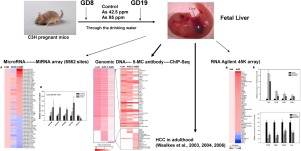当前位置:
X-MOL 学术
›
Toxicology
›
论文详情
Our official English website, www.x-mol.net, welcomes your
feedback! (Note: you will need to create a separate account there.)
Transplacental arsenic exposure produced 5-methylcytosine methylation changes and aberrant microRNA expressions in livers of male fetal mice.
Toxicology ( IF 4.8 ) Pub Date : 2020-02-14 , DOI: 10.1016/j.tox.2020.152409 Jie Liu 1 , Sumedha Gunewardena 2 , Julia Yue Cui 2 , Curtis D Klaassen 2 , Brian N Chorley 3 , J Christopher Corton 3
Toxicology ( IF 4.8 ) Pub Date : 2020-02-14 , DOI: 10.1016/j.tox.2020.152409 Jie Liu 1 , Sumedha Gunewardena 2 , Julia Yue Cui 2 , Curtis D Klaassen 2 , Brian N Chorley 3 , J Christopher Corton 3
Affiliation

|
Arsenic is a known human carcinogen. Early-life exposure to inorganic arsenic induces tumors in humans and in C3H mice. We hypothesized that arsenic exposure in utero may induce epigenetic changes at the level of DNA methylation and miRNA alterations that could lead to greater postnatal susceptibility to cancer. To test this hypothesis, pregnant C3H mice were given sodium arsenite at doses known to cause liver cancer (42.5 and 85 ppm in the drinking water) from gestation day 8-19, and the livers from male fetal mice were collected for analysis. The antibody against 5-methylcytosine was used to perform chromatin-immunoprecipitation coupled with sequencing (ChIP-Seq) to determine genome-wide methylation alterations. In utero arsenic exposure produced global DNA hypomethylation and an array of gene-specific DNA methylation changes, including hypomethylation of Cyclin D1 and hypermethylation of Tp53. Illumina Correlation Engine analysis revealed 260 methylation alterations that would affect 143 microRNAs. MicroRNA array further revealed 140 aberrantly expressed miRNAs out of the 718 miRNAs. The increased expression of miR-205, miR-203, miR-215, miR-34a, and decreased expression of miR-217 were confirmed by qPCR. Comparison of the methylation changes to those of microarray analyses indicates little if any correspondence between gene methylation and gene expression. The increased expression of Xist, Prrc2, Krit1, Nish, and decreased expression of Prss2, Spp1, Col1a2, and Lox were confirmed by qPCR. In summary, in utero arsenic exposure induced global alterations in DNA methylation and aberrant miRNA expression that might contribute to adult adverse outcomes including liver cancer.
中文翻译:

经胎盘砷暴露导致雄性胎鼠肝脏中 5-甲基胞嘧啶甲基化变化和异常 microRNA 表达。
砷是一种已知的人类致癌物。生命早期接触无机砷会诱发人类和 C3H 小鼠的肿瘤。我们假设子宫内砷暴露可能会引起 DNA 甲基化和 miRNA 改变水平的表观遗传变化,从而导致出生后更容易患癌症。为了检验这一假设,从妊娠第 8-19 天开始,给怀孕的 C3H 小鼠服用已知会导致肝癌的剂量的亚砷酸钠(饮用水中的浓度为 42.5 和 85 ppm),并收集雄性胎鼠的肝脏进行分析。使用针对 5-甲基胞嘧啶的抗体进行染色质免疫沉淀结合测序 (ChIP-Seq),以确定全基因组甲基化改变。子宫内砷暴露导致整体 DNA 低甲基化和一系列基因特异性 DNA 甲基化变化,包括 Cyclin D1 的低甲基化和 Tp53 的高甲基化。Illumina 关联引擎分析显示 260 个甲基化改变会影响 143 个 microRNA。MicroRNA 阵列进一步揭示了 718 个 miRNA 中的 140 个异常表达的 miRNA。qPCR 证实了 miR-205、miR-203、miR-215、miR-34a 的表达增加和 miR-217 的表达减少。将甲基化变化与微阵列分析的甲基化变化进行比较表明,基因甲基化和基因表达之间几乎没有对应关系。qPCR 证实 Xist、Prrc2、Krit1、Nish 表达增加,Prss2、Spp1、Col1a2 和 Lox 表达减少。总之,子宫内砷暴露引起 DNA 甲基化和 miRNA 表达异常的整体改变,这可能导致成人不良后果,包括肝癌。
更新日期:2020-02-20
中文翻译:

经胎盘砷暴露导致雄性胎鼠肝脏中 5-甲基胞嘧啶甲基化变化和异常 microRNA 表达。
砷是一种已知的人类致癌物。生命早期接触无机砷会诱发人类和 C3H 小鼠的肿瘤。我们假设子宫内砷暴露可能会引起 DNA 甲基化和 miRNA 改变水平的表观遗传变化,从而导致出生后更容易患癌症。为了检验这一假设,从妊娠第 8-19 天开始,给怀孕的 C3H 小鼠服用已知会导致肝癌的剂量的亚砷酸钠(饮用水中的浓度为 42.5 和 85 ppm),并收集雄性胎鼠的肝脏进行分析。使用针对 5-甲基胞嘧啶的抗体进行染色质免疫沉淀结合测序 (ChIP-Seq),以确定全基因组甲基化改变。子宫内砷暴露导致整体 DNA 低甲基化和一系列基因特异性 DNA 甲基化变化,包括 Cyclin D1 的低甲基化和 Tp53 的高甲基化。Illumina 关联引擎分析显示 260 个甲基化改变会影响 143 个 microRNA。MicroRNA 阵列进一步揭示了 718 个 miRNA 中的 140 个异常表达的 miRNA。qPCR 证实了 miR-205、miR-203、miR-215、miR-34a 的表达增加和 miR-217 的表达减少。将甲基化变化与微阵列分析的甲基化变化进行比较表明,基因甲基化和基因表达之间几乎没有对应关系。qPCR 证实 Xist、Prrc2、Krit1、Nish 表达增加,Prss2、Spp1、Col1a2 和 Lox 表达减少。总之,子宫内砷暴露引起 DNA 甲基化和 miRNA 表达异常的整体改变,这可能导致成人不良后果,包括肝癌。









































 京公网安备 11010802027423号
京公网安备 11010802027423号